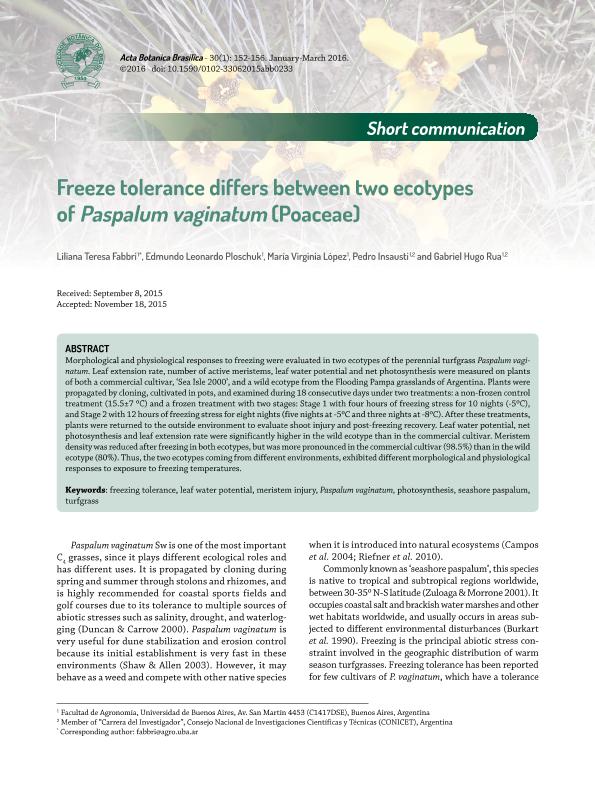Artículo
Freeze tolerance differs between two ecotypes of Paspalum vaginatum (Poaceae)
Fabbri, Liliana Teresa; Ploschuk, Edmundo Leonardo; López, María Virginia; Insausti, Pedro ; Rua, Gabriel Hugo
; Rua, Gabriel Hugo
 ; Rua, Gabriel Hugo
; Rua, Gabriel Hugo
Fecha de publicación:
01/2016
Editorial:
Sociedade Botanica do Brasil
Revista:
Acta Botanica Brasilica
ISSN:
0102-3306
e-ISSN:
1677-941X
Idioma:
Inglés
Tipo de recurso:
Artículo publicado
Clasificación temática:
Resumen
Morphological and physiological responses to freezing were evaluated in two ecotypes of the perennial turfgrass Paspalum vaginatum. Leaf extension rate, number of active meristems, leaf water potential and net photosynthesis were measured on plants of both a commercial cultivar, ‘Sea Isle 2000’, and a wild ecotype from the Flooding Pampa grasslands of Argentina. Plants were propagated by cloning, cultivated in pots, and examined during 18 consecutive days under two treatments: a non-frozen control treatment (15.5±7 °C) and a frozen treatment with two stages: Stage 1 with four hours of freezing stress for 10 nights (-5°C), and Stage 2 with 12 hours of freezing stress for eight nights (five nights at -5oC and three nights at -8°C). After these treatments, plants were returned to the outside environment to evaluate shoot injury and post-freezing recovery. Leaf water potential, net photosynthesis and leaf extension rate were significantly higher in the wild ecotype than in the commercial cultivar. Meristem density was reduced after freezing in both ecotypes, but was more pronounced in the commercial cultivar (98.5%) than in the wild ecotype (80%). Thus, the two ecotypes coming from different environments, exhibited different morphological and physiological responses to exposure to freezing temperatures.
Archivos asociados
Licencia
Identificadores
Colecciones
Articulos(OCA PQUE. CENTENARIO)
Articulos de OFICINA DE COORDINACION ADMINISTRATIVA PQUE. CENTENARIO
Articulos de OFICINA DE COORDINACION ADMINISTRATIVA PQUE. CENTENARIO
Citación
Fabbri, Liliana Teresa; Ploschuk, Edmundo Leonardo; López, María Virginia; Insausti, Pedro; Rua, Gabriel Hugo; Freeze tolerance differs between two ecotypes of Paspalum vaginatum (Poaceae); Sociedade Botanica do Brasil; Acta Botanica Brasilica; 30; 1; 1-2016; 152-156
Compartir
Altmétricas



